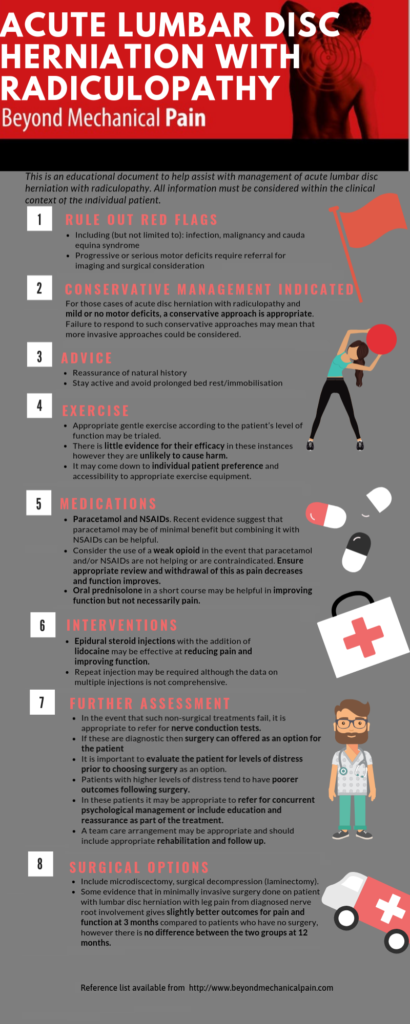This was written by Monica Noy and Alison Sim
A manual therapist NEVER needs an MRI to manage low back pain
– an opinion(ated) piece backed by research!
MRI findings will not change your management strategy
- There is very little correlation between pain and findings on an MRI or other imaging. Vast numbers of pain free individuals have disc bulges or spinal degenerative changes present on MRI. (Brinjikji, Leutmer, Comstock… et al, 2015; Jensen, Bran-Zawadski, Obuchowski… et al, 1994; Suri, Boyko, Goldberg… et al, 2014)
- If there are no red flags but you suspect a disc bulge or any form of spinal degeneration or osteoarthritis, an MRI might confirm (or not) those suspicions, but shouldn’t change your management strategy.
- If there are radicular signs and symptoms (sensory changes in a dermatomal distribution, weakness, loss of reflexes) without progressive worsening, an MRI that has already been conducted tells you where the disc bulge is, or how big it is, but should not change your management strategy.
- Best practice management in most back pain cases is conservative as illustrated by this handy, up to date guideline of management of acute low back pain with radicular signs and symptoms.
- Red flags WILL change your management strategy. If there are red flags or if there are no changes to radicular signs and symptoms after 2-4 weeks of conservative approaches, or if there is a continual worsening of symptoms, a referral to the appropriate medical professional is required. They will decide if an MRI is an appropriate course of action to help them make the decisions that need to be made and if more invasive treatments might be warranted.
MRI findings can make people worse
How can a non-invasive imaging modality make someone with LBP worse?
One word – FEAR. Images of jam donuts with bright red jelly exploding out the side, threats of surgery, crumbling, crusty spines, horror stories about uncles, friends or cousins who ended up in wheel chairs or damaged by surgery, or not getting surgery.
Medical and manual therapy culture, and subsequently society at large have alarming things to say about disc bulges and osteoarthritis. But those alarming warnings about slippages and crippling dysfunction do not apply to the majority of LBP sufferers. Still, the myths are pervasive, and have a lot of staying power. The higher the fear, the worse the outcomes.
MRI findings are a waste of money
Not only do these images place a huge financial burden on individuals, health and insurance systems, there is plenty of evidence to show that they drive up both invasive interventions and cost in episodes of low back pain, regardless of the presence of radiculopathy. One study found that having an early MRI cost an average of around $13,000 in subsequent healthcare costs, compared to not having the MRI. (Webster, Bauer, YoonSun Choi, Cifuentes, & Pransky, 2013.) Just imagine what else could be done with that money!!
If MRI images provide questionably useful information that has no bearing on management or outcome, then we have little to no reason to seek these images, or request that our patient seeks them. (Rainville, Smeets, Bendix… et al, 2011; Webster, Bauer, YoonSun Choi, Cifuentes, & Pransky, 2013; Suri et al, 2014).
MRI findings are not a necessity
If you already reassure patients that their back pain is likely to get better, or assure them that an MRI isn’t necessary and/or follow other current guidelines for management of low back (Chou, Qaseem, Snow… et al, 2007) then your help is needed. We can encourage colleagues who still default to the idea that what they see in MRI or other imaging is going to inform their treatment to engage with the current scientific understanding of MRI imaging, symptom presentation, pain science and outcome management.
Continued discussions about whether the degeneration at L5/SI is causing pain are really unhelpful, for both patients and clinicians.
***** It just doesn’t fit with the science *********
The Science
Images, information and further studies to help educate your patients on these issues:
https://ptbraintrust.wordpress.com/2016/05/09/patient-education-binder/
Brinjikji,W., Leutmer, P., Comstock B., … et al (2015). Systematic literature review of imaging features of spinal degeneration in asymptomatic populations. American Journal of Neuroradiology, 36(4), 811-816.
Chou, R., Qaseem, A., Snow, V., et al.(2007). Diagnosis and treatment of low back pain: a joint clinical practice guideline from the American College of Physicians and the American Pain Society. Annals of Internal Medicine, 147,478–91.
Suri, P., Boyko, E., Goldberg, J., Forsberg, C., & Jarvik, J. (2014). Longitudinal associations between incident lumbar spine MRI findings and chronic low back pain or radicular symptoms: retrospective analysis of data from the longitudinal assessment of imaging and disability of the back (LAIDBACK). BMC Musculoskeletal Disorders, 15,152.
Jensen, M., Brant-Zawadski, M., Obuchowski, N., Modic, M., Malkasian, D.,& Ross, J. (1994) Magnetic resonance imaging of the lumbar spine in people without back pain. New England Journal of Medicine, 331(2), 69–73.
Rainville, J., Smeets, R., Bendix, T., Tveito, T., Poiraudeau, S., & Indahl, A. (2011). Fear-avoidance beliefs and pain avoidance in low back pain–translating research into clinical practice. Spine Journal, 11(9), 895-903.
Webster, B., Bauer, A., YoonSun Choi, M., Cifuentes, M., & Pransky, G. (2013). Iatrogenic Consequences of Early Magnetic Resonance Imaging in Acute, Work-Related, Disabling Low Back Pain. Spine, 38(22), 1939-1946.


